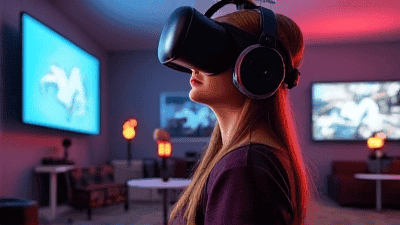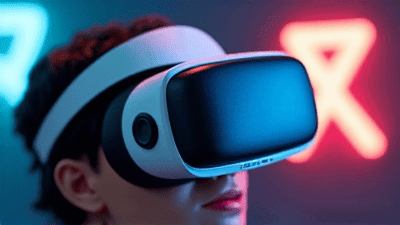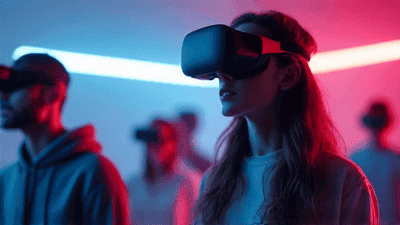
VR Gaming: Immersive Frontiers Redefining Entertainment as We Know It
The landscape of digital entertainment is on the cusp of a profound transformation, spearheaded by the rapid evolution of virtual reality (VR) gaming. Far from a mere novelty, VR gaming is redefining how we interact with digital worlds, moving beyond two-dimensional screens to create deeply immersive, three-dimensional experiences. This shift represents a pivotal moment, challenging our conventional understanding of entertainment and user engagement by inviting participants directly into the heart of the action, presenting complex mechanisms of sensory and psychological immersion that warrant in-depth discussion.
VR's journey from speculative technology to a burgeoning industry underscores its critical importance and multifaceted impact across various sectors. For the scientific community, it offers new frontiers in human-computer interaction and cognitive psychology; for the industry, it presents unparalleled opportunities in game development, hardware innovation, and digital commerce; and for society, it promises novel forms of education, training, and social connection. Current developments, such as advancements in standalone headsets and haptic feedback systems, are pushing VR into the mainstream, while debates around digital ethics and the "metaverse" concept highlight its far-reaching implications. What impact would it have on our understanding or practice of entertainment if we failed to fully comprehend VR gaming's full potential? The answer is simple: we risk overlooking the next great leap in human experience.
The Dawn of Immersive Realities

Beyond Screens: Redefining Presence and Interaction
Virtual Reality (VR) is fundamentally an artificial environment that is experienced through sensory stimuli (primarily sight and sound) provided by a computer, creating the illusion of being in an alternate world. The core of VR gaming's revolutionary power lies in its ability to generate "presence"—a powerful psychological phenomenon where a user feels genuinely there within the virtual environment, rather than merely observing it. This sense of presence is meticulously crafted through a combination of high-fidelity visual displays, offering wide fields of view (FOV) and crisp resolutions that minimize screen-door effect, and sophisticated spatial audio, which accurately simulates sound direction and distance. For instance, in Half-Life: Alyx, the subtle sound of a headcrab skittering behind you can induce a visceral sense of dread, demonstrating VR's potent emotional impact.
Beyond audiovisuals, haptic feedback further bridges the gap between the virtual and physical. Controllers that vibrate in response to in-game events, like pulling a bowstring or taking damage, add a tactile dimension that reinforces immersion. Imagine the satisfaction of feeling the distinct "thwack" as you slice a virtual cube in Beat Saber, or the subtle resistance as you manipulate a digital object. This multi-sensory engagement transforms passive consumption into active participation, making the virtual world feel tangible and responsive. VR serves as a digital portal, not just displaying a world, but inviting you to step inside and live within it. Research consistently shows that a strong sense of presence enhances user engagement, emotional response, and memory recall within virtual environments, marking a significant departure from traditional flat-screen gaming.
Reshaping Gameplay and Social Dynamics
Innovative Mechanics and Connected Virtual Worlds
VR profoundly alters game mechanics, moving beyond button presses to embrace natural, intuitive interactions. Room-scale VR, for example, allows players to physically walk around and interact with virtual objects, enabling experiences like exploring ancient ruins or dodging projectiles with actual body movements. Games like Superhot VR leverage this, requiring players to physically duck, weave, and throw objects, translating real-world spatial awareness into gameplay. This contrasts sharply with traditional gaming where spatial interaction is typically mediated by a joystick and buttons. Natural locomotion options, such as arm-swinging or smooth walking with joystick controls, are continually refined to balance immersion with comfort, while teleportation offers a common comfort-focused alternative.
The impact extends to social gaming, where VR fosters unprecedented levels of connection. Multiplayer VR titles like VRChat or Rec Room allow users to inhabit avatars, speak with their own voices, and use body language (tracked via headsets and controllers) to convey emotion and intent. This creates a sense of shared space and intimacy that traditional online gaming struggles to replicate. The burgeoning concept of the "metaverse" builds upon this, envisioning persistent, interconnected virtual worlds where users can socialize, work, play, and engage in commerce.
Consider the growth in VR hardware and content. The following table illustrates the increasing adoption of standalone VR headsets, a key driver for accessibility and mainstream appeal:
| Year | Global Shipments (Millions) | Growth (YoY) | Key Product Drivers |
|---|---|---|---|
| 2020 | 3.5 | N/A | Oculus Quest 2 |
| 2021 | 8.0 | +128% | Oculus Quest 2 |
| 2022 | 9.6 | +20% | Meta Quest 2/Pro, Pico 4 |
This data highlights a substantial increase in VR headset shipments, particularly driven by standalone devices that remove the need for powerful PCs or external sensors, democratizing access to VR. This growth directly correlates with an expanding library of innovative VR games that capitalize on these unique interaction models, pushing boundaries in storytelling, puzzle-solving, and competitive play. The sheer scale and sense of physical embodiment within these virtual spaces create compelling narratives and social experiences that are simply unachievable through conventional media.
Navigating the Virtual Frontier

Overcoming Hurdles and Unlocking Future Potential
Despite its transformative potential, VR gaming faces several significant challenges that impede its widespread adoption. Hardware cost remains a barrier for many consumers, though the introduction of more affordable standalone headsets like the Meta Quest series has begun to mitigate this. Accessibility is another concern, encompassing not only financial aspects but also comfort and ease of use. Motion sickness, often referred to as "sim-sickness," affects a portion of users due to a sensory mismatch between visual input and inner ear balance, leading to discomfort and nausea. While developers implement comfort options, it remains a hurdle for first-time users.
The content library, though growing, still requires more "killer apps"—experiences so compelling they justify the hardware investment for a broader audience. Input methods, while advancing with haptic feedback, are still evolving towards more seamless and intuitive interaction, with research into haptic gloves and full-body tracking aiming for greater fidelity. Battery life on standalone devices also presents a limitation for extended play sessions. However, the industry is actively addressing these issues. Technological advancements, such as higher resolution displays that reduce motion blur and improved refresh rates, are designed to enhance comfort. Research into physiological responses and personalized comfort settings continues. The future of VR also grapples with ethical considerations, including data privacy in virtual worlds and the potential for addiction or escapism, which require careful navigation as the technology matures.
Conclusion
The journey through the burgeoning world of VR gaming reveals a technology poised to fundamentally redefine entertainment as we know it. We have explored how VR's unique ability to generate "presence" transcends traditional screen-based interactions, creating deeply immersive realities that engage users on unprecedented psychological and sensory levels. This unparalleled immersion is achieved through high-fidelity visuals, sophisticated spatial audio, and evolving haptic feedback systems, transforming passive viewing into active, embodied participation. Furthermore, VR gaming is not merely a visual upgrade; it fundamentally reshapes gameplay mechanics, encouraging natural interaction and physical engagement. Crucially, it is fostering a new era of social connection within interconnected virtual worlds, offering profound experiences of shared presence and community that push the boundaries of online interaction. VR is not just another platform; it is a paradigm shift, positioning itself as a core component of future entertainment landscapes.
Looking ahead, the trajectory of VR gaming is one of continuous innovation and expansion. We can anticipate significant breakthroughs in hardware, including lighter, more powerful standalone units, advanced haptic suits that offer full-body tactile feedback, and potentially even brain-computer interfaces that promise seamless interaction with virtual environments. The convergence of VR with augmented reality (AR) will blur the lines between physical and digital, creating hybrid realities that overlay virtual elements onto our everyday lives. Macro scientific policies will play a crucial role in shaping the ethical frameworks for these digital spaces, addressing concerns around data ownership, digital identity, and intellectual property within virtual economies. Interdisciplinary integration with fields like neuroscience, psychology, and design will be paramount in overcoming challenges such as motion sickness and accessibility. The industry must prioritize content diversity, standardization for cross-platform compatibility, and educational initiatives to ensure broad understanding and responsible adoption. Continuous research and development are not just desirable but essential to unlock the full potential of VR, ensuring it evolves into a truly accessible, enriching, and profoundly engaging medium for all.
Frequently Asked Questions (FAQ)

Q: What causes motion sickness in VR and how can it be mitigated? A: Motion sickness in VR, often called "sim-sickness," primarily stems from a sensory mismatch between what your eyes perceive and what your inner ear (vestibular system) detects. When you move through a virtual environment (e.g., walking forward with a joystick) but your physical body remains stationary, your eyes tell your brain you're moving, while your vestibular system reports no actual physical acceleration or deceleration. This conflict can trigger symptoms like nausea, dizziness, sweating, and disorientation, as your brain struggles to reconcile the contradictory signals. It's akin to seasickness, where your eyes might be focused on a stable object inside a moving ship, while your body feels the movement.
Mitigating VR motion sickness involves several strategies, often combining technological solutions with user acclimatization. From a technical standpoint, developers implement various "comfort options." These include teleportation (instantly jumping from one point to another) instead of smooth locomotion, which eliminates perceived motion. "Vignetting," which darkens the peripheral vision during movement, can reduce the scope of conflicting visual input. Increasing the refresh rate and resolution of VR headsets also helps, as smoother visuals reduce perceived lag and jitter. For users, gradual exposure is key; start with experiences that have minimal motion or strong comfort settings, and take frequent breaks. Staying hydrated and avoiding playing on an empty stomach can help. Some users find relief with ginger chews or over-the-counter anti-nausea medications. It's a personal journey, and finding the right combination of settings and practices can significantly improve comfort and enjoyment.
Q: How is VR gaming different from traditional gaming, beyond just visuals? A: While superior visuals are an obvious differentiator, VR gaming offers a fundamentally different experiential paradigm compared to traditional gaming, going far beyond graphical fidelity. The most significant distinction is the sense of "presence" we discussed earlier. In traditional gaming, you observe a world on a screen; in VR, you are in the world. This shifts your role from an external observer to an internal participant, leading to a much stronger emotional and psychological connection to the game.
This presence impacts gameplay in several profound ways. Firstly, spatial interaction becomes natural. Instead of pressing a button to pick up an item, you physically reach out and grab it. Instead of moving a character with a joystick, you might physically walk, duck, or lean to navigate the environment or dodge an attack. This physical embodiment drastically changes puzzle design, combat mechanics, and exploration. Secondly, scale and perspective are dramatically altered. A virtual skyscraper or a towering boss feels genuinely immense and imposing in VR, eliciting a visceral reaction that a flat screen cannot replicate. Thirdly, social immersion is unparalleled. In multiplayer VR, you share a virtual space with other players, interacting with their avatars through natural voice communication and body language. This creates a much deeper sense of camaraderie or rivalry than traditional online multiplayer. Finally, agency and emotional impact are heightened. The direct interaction and sense of being "there" mean that narrative moments, jump scares, or moments of triumph land with far greater personal resonance. VR is about embodying a role and influencing a world directly, rather than merely controlling a character within it.







